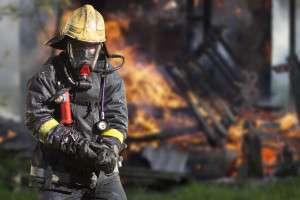We know asbestos exposure was common among occupations like construction workers, carpenters, oil refinery workers and members of the U.S. military. There is one occupation, however, that is also at risk and doesn’t seem to get as much attention. That occupation is firefighting.
Firefighters risk their lives by entering burning, crumbling buildings and structures. They are the first responders who put it all on the line to extinguish fires and save lives. Many times the buildings they enter were constructed with asbestos and asbestos products. As the fire burns, its high temperature actually causes asbestos fibers in the materials to break down even further. This can distribute the fibers into the air faster.
This is where the main dangers of asbestos exposure and firefighters come into play. It is usually the products inside the burning building that create the biggest hazards – items like roofing materials, insulation, vinyl, shingles, floor tiles that were commonly created with asbestos. The culmination of a burning building with deteriorating asbestos products can endanger rescue workers and firefighters in such situations.
An example of this type of asbestos exposure comes from the clean-up efforts of the 9/11 attacks. Firefighters and rescue workers spent hours at Ground Zero working among dust, smoke and debris that contained asbestos and other harmful particles. The towers had been built with asbestos products, and as they collapsed, the asbestos fibers broke down and became airborne.
How Firefighters Can Avoid Asbestos Exposure
There are a few things firefighters and other rescue workers can do to prevent dangerous asbestos exposure, which can lead to mesothelioma and other asbestos-related diseases. According to the State of Connecticut Department of Emergency Services & Public Protection, here are some tips firefighters should follow:
- Continue to wear a self-contained breathing apparatus (SCBA) while searching for hotspots during the overhaul stage.
- Make sure to wet any parts of the building where firefighters are working to keep the amount of asbestos fibers released into the air to a minimum.
- Wear protective equipment for any venting and entry techniques, such as opening walls.
- If possible, wash all equipment and clothing at the scene to limit the spread of toxins past the work site.
Older structures built prior to the mid-1900s with asbestos-containing products will continue to occasionally catch fire and burn down. As this happens, firefighters will continue to experience ongoing risk for asbestos exposure. It’s important to know and understand this risk, as well as any protective measures firefighters can use to safeguard against asbestos exposure and mesothelioma.





